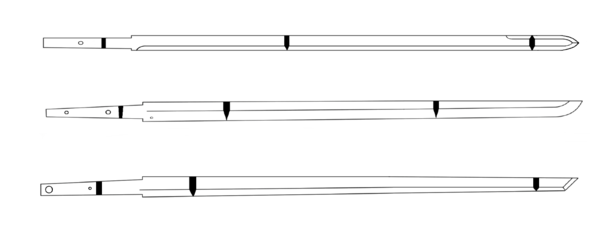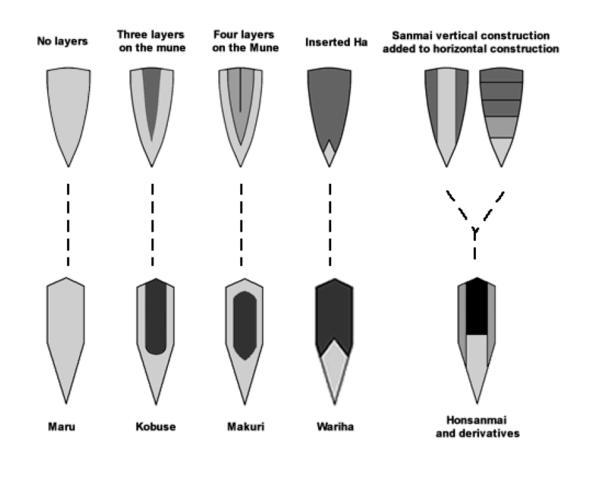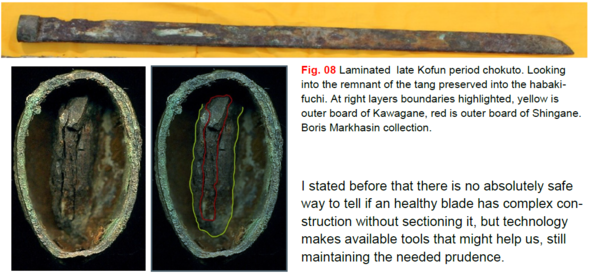-
Posts
2,121 -
Joined
-
Last visited
-
Days Won
8
Everything posted by Carlo Giuseppe Tacchini
-
-
-
Thanks Pete. I lost the link to Keith's article.Figure 3 in the second link points out what I meant.
-
Ed, I was under the impression that Niku was introduced exactly to diminish the Surface of the blade in contact with the soft target. A v shaped blade has more Surface in contact with the flesh than one with proper niku. The curvature of niku displaces flesh not allowing it to enter in contact with the upper part of the blade. This of course applies not only to shinogizukuri blades but to Hirazukuri blades with proper niku as well.
-
Sure, and that's because they are popular in modern cutting competition. However tatami mat have no armor and doesn't byte back with another sword, the two reasons that made Shinogizukuri blades preferred in wartime periods. When the Pax Tokugawa covered Japan, they remained the fashionable ones among samurai.
-
The matter is much older than appears in these comments. The Shinogi (ridge) first appeared in China at least during the Han dynasty and entered Japan as soon as the trade allowed it. Shinogi (ridge) is a natural addition to the flat (Hirazukuri) blades in order to obtain a more performing sword and is mainly intended for long and medium blades. It firstly appeared in Kirihazukuri blades. These blades has the advantage in having a thicker and consequently heavier and more resistant body maintaining a thin, hence sharp, edge thru the application of an angle. The result is a 5 sided cross section. This is a very good enhancement for swords that might strike hard objects as armor or bones. A thinner triangular section (Hirazukuri) is sharper but also more prone to break due to the shocks mentioned. More, the beefier upper section of Kirihazukuri gives more weight to the kinetic action, and this possibly remedied to the lesser cutting ability. With time swordsmiths realized that to move up the Shinogi would mean to add sharpness to the edge, in some way mixing the Kirihazukuri (upper part of the blade, above the Shinogi) and Hirazukuri (lower part of the blade, below the Shinogi) maintaining a five sides cross section. This proved to be the more effective cross section for long blades in Japanese history, with a perfect mix of resistance, weight placement and cutting ability.
-
Bazza, try with Firefox. The link works fine for me...
-
I edited my post. Seems you're right.
-
I concur with you in every point you give however in this particular case and in the process seems to me the togishi separated in two this feature. If so why the tip of the hamachi remains ? This is what puzzle me, not the shape, dimensions or orientation of the feature. Possibly I miss something... EDIT : the oshigata reports what I see as an activity and the color in the picture is different from the one of the hagire. Not sure if they are the same thing now...
-

"On the origins of NihonTo"
Carlo Giuseppe Tacchini replied to Carlo Giuseppe Tacchini's topic in Nihonto
John, how's you database on Samurai Banners ? Dr Brian, I still dream your lovely house, even if a bit cold for an italian Gabriel, I wonder which mega-camera are you playing with now. -
I concur. It passes thru the very tip of the Hamachi. If it is a crack, the tip should fall apart. My 2 cents.
-
It's a good pic, hagire is clear even without magnification. If I'm right...
-
Let see if I'm still able to cover me of shame the same way as the good old days... :-) PS the spoiler doesn't work for pics (or I'm not able to use it). So if anybody prefer to search without seeing what I believe to have found please don't enlarge the following picture.
-

Interesting Pdf Articles And Links
Carlo Giuseppe Tacchini replied to Brian's topic in General Nihonto Related Discussion
Brian, this is for sure free. Don't know if it deserve to stay here cause is more an archeological study than an article on nihonto. You decide :-) http://www.webalice.it/tsubame1/ZZZZZZ_ESSAY.htm -
honest togishi should tell you if the blade deserve (and can suffer) a polish, but I guess your polisher hasn't handled the blade yet. To me, seems a bit "tired".
-
... and seems neither hamachi nor munemachi left....
-
The idea that all the different constructions started in 1450 is at least debatable (to be fair). The origins of all the construction method used in fully developed Nihonto (as we surely consider all Koto) were already present in early blades forged in Japan following the chinese technology (we should always remember where Japanese took their technology to later improve it...). I can't post the whole process Suenaga discuss in his work however you can read it at pages 16/17 of my essay. Anyway first row ancient chokuto forged in Japan, second row "modern" construction methods.
-
The following is an image of part of the Mune and all the Nakago of a long straight Tachi and that is dating to ca. 600 AD. Nagasa is 85.5 cm with a 17 cm tsuka, and a 1cm Kasane (Fig 09). A radiograph has been taken with a commercial technology called Gamma Radiography (Sr 92 source) used to detect structural defects in metals. The result of the radiograph has been ad-justed in saturation to obtain the picture hereunder.
-
Hi Ken. Ohmura should be taken with a grain of salt, IMHO. Of course might be some of the best Koto haven't inner soft core but evidences tell us that blades already forgedin Japan (not imported) had the shingane as their chinese counterparts. Blade pic courtesy of Boris Markasin :
-
Piers, at this time the dimension of your collection of Japanese artworks and items in general should have forced you to change home... :-) .
-
Indeed. More pics should help to find if it is so.
-
Hi Peter. When taking pictures of a Nakago the habaki should be removed. It might cover interesting information about the blade .. Fresh tsukamaki ?
-

"On the origins of NihonTo"
Carlo Giuseppe Tacchini replied to Carlo Giuseppe Tacchini's topic in Nihonto
thanks Jean. Thank to all. -

Recovering Lost Signatures
Carlo Giuseppe Tacchini replied to Michael Kwok's topic in General Nihonto Related Discussion
Not sure they have time to follow boards but I'll make an invitation. If I'm not wrong Markus has good and more fresh contacts with them and maybe he would have better chances than me. Too much time they don't ear from me...










